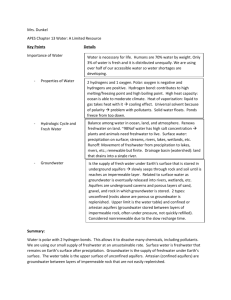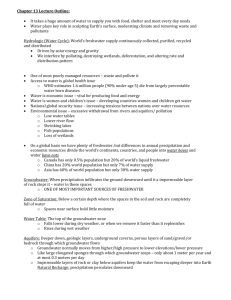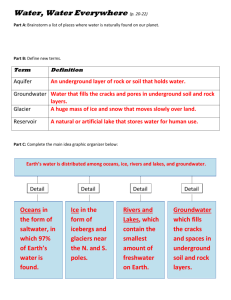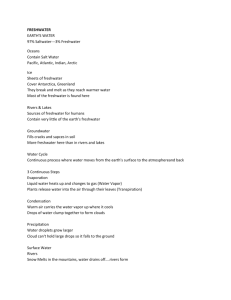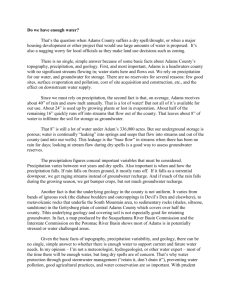Session: Coastal Biogeochemistry: from land to continental slope
advertisement
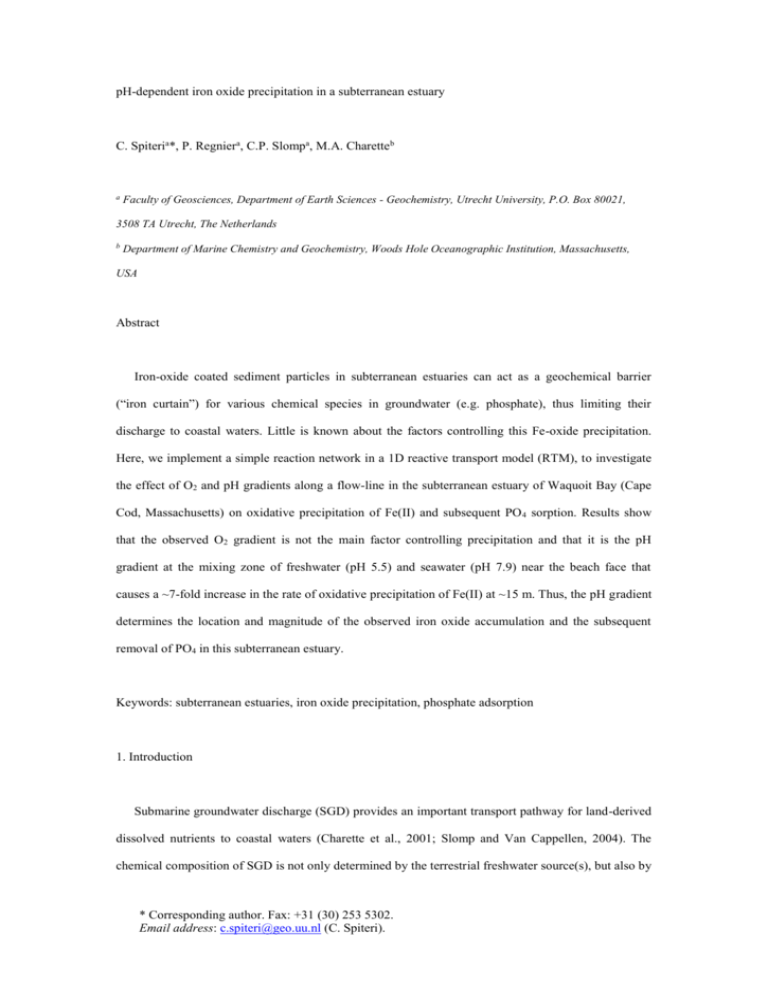
pH-dependent iron oxide precipitation in a subterranean estuary C. Spiteria*, P. Regniera, C.P. Slompa, M.A. Charetteb a Faculty of Geosciences, Department of Earth Sciences - Geochemistry, Utrecht University, P.O. Box 80021, 3508 TA Utrecht, The Netherlands b Department of Marine Chemistry and Geochemistry, Woods Hole Oceanographic Institution, Massachusetts, USA Abstract Iron-oxide coated sediment particles in subterranean estuaries can act as a geochemical barrier (“iron curtain”) for various chemical species in groundwater (e.g. phosphate), thus limiting their discharge to coastal waters. Little is known about the factors controlling this Fe-oxide precipitation. Here, we implement a simple reaction network in a 1D reactive transport model (RTM), to investigate the effect of O2 and pH gradients along a flow-line in the subterranean estuary of Waquoit Bay (Cape Cod, Massachusetts) on oxidative precipitation of Fe(II) and subsequent PO 4 sorption. Results show that the observed O2 gradient is not the main factor controlling precipitation and that it is the pH gradient at the mixing zone of freshwater (pH 5.5) and seawater (pH 7.9) near the beach face that causes a ~7-fold increase in the rate of oxidative precipitation of Fe(II) at ~15 m. Thus, the pH gradient determines the location and magnitude of the observed iron oxide accumulation and the subsequent removal of PO4 in this subterranean estuary. Keywords: subterranean estuaries, iron oxide precipitation, phosphate adsorption 1. Introduction Submarine groundwater discharge (SGD) provides an important transport pathway for land-derived dissolved nutrients to coastal waters (Charette et al., 2001; Slomp and Van Cappellen, 2004). The chemical composition of SGD is not only determined by the terrestrial freshwater source(s), but also by * Corresponding author. Fax: +31 (30) 253 5302. Email address: c.spiteri@geo.uu.nl (C. Spiteri). the biogeochemical processes occurring along the groundwater flow path, particularly in the “subterranean estuary” where freshwater and seawater mix (Moore, 1999). Removal of dissolved metals and nutrients subterranean estuaries is thought to be mainly controlled by the redox characteristics of the freshwater and seawater (Slomp and Van Cappellen, 2004). For instance, the accumulation of iron oxides observed near the freshwater-seawater interface of Waquoit Bay (Cape Cod, Massachusetts; Fig. 1), referred to as the “iron curtain”, has been attributed to the oxidative precipitation of groundwater Fe upon transport through oxygenated coastal sediments (Charette and Sholkovitz, 2002). Here, we propose an alternative mechanism, where the precipitation of Fe oxides results from the differences in pH between the freshwater and seawater. To test this hypothesis, we use a 1D RTM to assess the combined effects of O2 and pH changes on Fe oxide precipitation and the subsequent phosphate (PO4) removal along a flowline in the subterranean estuary of Waquoit Bay. 2. Hydrogeology and biogeochemistry of the Waquoit Bay subterranean estuary Waquoit Bay is a shallow estuary located on the southern shoreline of Cape Cod (Fig. 1). A significant portion of the freshwater input and material fluxes to the bay occurs as SGD (Charette et al., 2001). To investigate the chemical constituents of the SGD, 6 piezometers were installed along a transect perpendicular to the coast at the head of the bay where the surface aquifer consists of unconfined, permeable sand (Micheal, 2005). Groundwater samples were collected in June 2004 and analyzed as described elsewhere (Talbot et al., 2003; Charette et al., 2005). Fig. 2 shows depth profiles of total dissolved Fe and PO4 along the transect. The range of observed pH values and the vertically averaged concentrations are presented in Fig. 3. Salinity measurements indicate a sharp Ghyben-Herzberg type freshwater-seawater interface (Fig. 2), and surface mixing of seawater and freshwater at the intertidal piezometers PZ-3 and PZ-5 (not shown). A distinct freshwater Fe plume that disappears as the groundwater flows seaward is clearly identified in Fig. 2. At around PZ-3, the Fe content of the dark red, yellow and orange subsurface sands ranges from 2500 to 4100 ppm, which is 10 to 15 times higher than in “control” sediment (Charette and Sholkovitz, 2002). Although the freshwater PO4 concentrations are relatively low (maximum ~5 M), phosphate removal is observed as the Fe and PO4 plumes overlap. Measurements of dissolved oxygen 2 (O2) (not shown) show relatively low values (40 M) in the landward piezometers, increasing up to ~200 M towards PZ-3 and PZ-5. The average pH at the first piezometer in the transect (PZ-7), is 5.5 while at the seaward boundary, (PZ-12), the pH is 7.9 (Fig. 3). 3. Model Description The processes included in the Biogeochemical Reaction Network Simulator (BRNS), a flexible 1D RTM (Regnier et al., 2003; Rodríguez Aguilera et al., 2005), are pH-dependent oxidative precipitation of Fe(II), PO4 adsorption onto Fe oxides and advective plus dispersive groundwater transport (Table 1). At the upstream boundary (x = 0 m), a Dirichlet boundary condition is applied, which fixes the concentration of Fe(II), O2, PO4 and pH at the freshwater side of the domain (Table 2). The Fe(II) concentration is set equal to the measured dissolved Fe, based on field measurements (Charette et al., 2005). At the outflow (x = 20 m), a zero concentration gradient boundary condition is specified for all dissolved chemical species. Even though it would be possible to incorporate pH and O 2 as master variables in the RTM (e.g. Rodríguez Aguilera et al., 2005), the current dataset for Waquoit Bay does not allow the reaction network required to model these variables to be fully constrained. Instead, both O2 and pH are implemented as forcing functions, either as constant values or as a longitudinal gradient along the flow line (Table 2). The solid species, i.e. Fe oxides (Fe(OH)3) and Fe-bound phosphate (FeP) are considered immobile and hence are only affected by local biogeochemical transformations. In the model, we represent the pH-dependent Fe(II) oxidation by O2 as: FeII k FeII O d FeII ko FeII k11 2 2 2 2 dt H H (1) where ko = 252 M-1 yr-1, k1 = 7.9 x 108 M-1 yr-1, k2 = 252 x 1014 M-1 yr-1 are rate constants corrected for a temperature of 10 C. The apparent equilibrium constants 1 and 2 are equal to 3.2 x 10-10 M and 2.5 x 10-21 M2 respectively (Martin, 2003). Our formulation ignores the heterogeneous catalysis of the metal oxide surfaces that enhances the oxidation process at pH values above 7 (Martin, 2003). Equation (1) leads to a progressive increase in the rate of oxidation with O 2 as the dominant hydrolysis species 3 shifts from [Fe(H2O)6]2+ to [Fe(H2O)5OH]+ and further to [Fe(H2O)4(OH)2]0 with increasing pH. In the pH range considered here, a unit increase in pH will cause a 100-fold increase in the overall reaction rate. Adsorption of phosphate onto the Fe oxides is assumed to follow a Langmuir isotherm, in which the extent of sorption is limited by the amount of available surface sites, X T (mol dm-3): Fe P = αX T ΣPO4 1+ αΣPO4 with = Kd * and XT = 0.1 * [Fe(OH)3] (2) In Equation (2), Kd is the dimensionless distribution coefficient and XT defines the amount of Fe oxides available for P sorption, assuming a [Fe(OH)3] : [Fe-P] maximum ratio of 10 (Slomp et al., 1996). 4. Model results and discussion In a first simulation, the pH is maintained constant over the 1D flowline (pH = 5.7). In this case, the model predicts a gradual drop in the Fe(II) and PO4 in the seaward direction which is significantly smaller than the decline observed in the field. Most Fe oxide precipitation occurs in the freshwater part. (Fig. 3). In contrast, in a simulation with an increasing pH (5.7 to 7.9), Fe-oxide precipitation rates increase 7-fold at ~15 m and a peak in Fe-oxides is formed. The latter location is consistent with the zone of major Fe-oxide accumulation observed in the field (Charette and Sholkovitz, 2002). The complete disappearance of groundwater Fe(II) observed in the seaward direction (Figs. 2 and 3) is also well captured by the model that includes pH-dependent Fe(II) oxidation. Using either constant O2 concentrations (40 M) or a seaward increase in O2 (from 40 to 200 M), does not affect the model results significantly, implying that changes in the redox characteristics of the subterranean estuary in Waquoit Bay play a minor role in the removal of Fe(II). Because of the enhanced precipitation of Fe oxides, more groundwater PO4 is removed when the pH dependency of the precipitation of Fe oxides is considered (Fig. 3). 4 5. Conclusions Using a 1D RTM, applied to a groundwater flowline of Waquoit Bay subterranean estuary, we show that the pH gradient in the mixing zone of freshwater and seawater at the beach face is the key factor driving the formation of the “iron curtain”. The pH-dependent Fe oxide precipitation explains the location and magnitude of the Fe-oxide coated sediments observed in the field and the concomitant removal of groundwater Fe. Results also indicate that the generation of “iron curtains” can significantly attenuate dissolved PO4 in groundwater prior to discharge to the coastal waters. Acknowledgements Financial support was provided by the Netherlands Organisation for Scientific Research (NWO) and WHOI Guest Student Program (grants to C. Spiteri), the Royal Netherlands Academy of Arts and Sciences (KNAW) (fellowship to C.P. Slomp) and US National Science Foundation NSFOCE0095384 and NSF-OCE0425061 (grants to M.A. Charette). References Charette, M.A., Buesseler K.O., Andrews, J.E., 2001. Utility of radium isotopes for evaluating the input and transport of groundwater-derived nitrogen to a Cape Cod estuary. Limnology and Oceanography 46, 465-470. Charette, M.A., Sholkovitz, E.R., 2002. Oxidative precipitation of groundwater-derived ferrous iron in the subterranean estuary of a coastal bay. Geophysical Research Letters 29, art. no.-1444. Charette, M.A., Sholkovitz, E.R., Hansel C.M., 2005. Trace element cycling in a subterranean estuary: Part 1. Geochemistry of the permeable sediments. Geochimica et Cosmochimica Acta, in press. Martin, S.T., 2003. Precipitation and Dissolution of Iron and Manganese Oxides, In: Grassian, V. H. (Ed.), Environmental Catalysis. Marcel-Dekker. Micheal, H.A., 2005. Seasonal Dynamics in Coastal Aquifers: Investigation of Submarine Groundwater Discharge through Field Measurements and Numerical Models, PhD Thesis, Department of Civil and Environmental Engineering, Massachusetts Institute of Technology Moore, W.S., 1999. The subterranean estuary: a reaction zone of ground water and sea water. Marine Chemistry 65, 111-126. Regnier, P., Jourabchi, P., Slomp, C.P., 2003. Reactive-transport modeling as a technique for understanding coupled biogeochemical processes in surface and subsurface environments. Netherlands Journal of Geosciences 82, 5-18. 5 Rodríguez Aguilera, D., Jourabchi, P., Spiteri, C., Regnier, P., 2005. A knowledge-based reactive transport approach for the simulation of biogeochemical dynamics in earth systems. Geochemistry, Geophysics and Geosystems, in press. Slomp, C.P., Van der Gaast, S.J., Van Raaphorst, W., 1996. Phosphorus binding by poorly crystalline iron oxides in North Sea sediments. Marine Chemistry 52, 55-73. Slomp, C.P., Van Cappellen, P., 2004. Nutrient inputs to the coastal ocean through submarine groundwater discharge: controls and potential impact. Journal of Hydrology 295, 64-86. Talbot, J. M., Kroeger, K.D., Rago A., Allen, M.C., Charette, M.A., 2003. Nitrogen flux and speciation through the subterranean estuary of Waquoit Bay, Massachusetts. Biological Bulletin 205, 244-245 6


